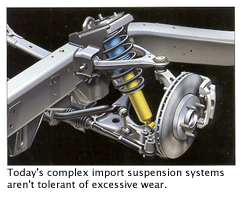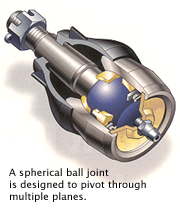Too often, shop owners and technicians alike assume that suspension systems haven’t changed much in the past 20 years. In reality, nothing could be farther from the truth because today’s import vehicle may incorporate a number of technologies that can be affected by worn steering and suspension components.
 To illustrate, we’re beginning to see electronic stability controls integrated into many vehicle platforms. In other cases, we may also begin to see rear-steer capabilities appear in long-wheel-base vehicles. To be effective, either of these technologies demands vehicle platforms that maintain precise steering and suspension system geometries.
To illustrate, we’re beginning to see electronic stability controls integrated into many vehicle platforms. In other cases, we may also begin to see rear-steer capabilities appear in long-wheel-base vehicles. To be effective, either of these technologies demands vehicle platforms that maintain precise steering and suspension system geometries.
In years past, some alignment technicians compensated for worn components by adding small amounts of toe or camber angle to a wheel alignment. While this strategy might be somewhat effective in passive steering systems, it may not work in active systems that may require precise feedback from the steering system. In addition, many import vehicles are now supplied with wide, low-aspect ratio tires and wheels that are very sensitive to minor changes in camber and toe angle.
Since worn ball joints and suspension bushings won’t hold the steering or suspension in the proper alignment, the effect will be worn tires and a general loss of handling qualities. Whatever the case, today’s complex import suspension systems aren’t tolerant of excessive wear because a worn bushing or ball joint can result in an annoying suspension knock, loss of steering centering or a deviation in driveline thrust angle.
BUSHING DETERIORATION
Most suspension system components pivot upon a rubber bushing that is compressed between an inner and outer metal sleeve. Because the compressed rubber bushing has no moving parts, it allows a maximum range of travel throughout a single plane without the frictional wear created in a conventional metal-to-metal bushing. Unfortunately, as the bushing ages, it acquires a “set” that is easily disturbed when a vehicle’s steering system is realigned. When this happens, the bushing begins to separate from its metal sleeve and becomes, in essence, a frictional wearing component.
As the rubber begins to twist inside the sleeve, excess clearance develops in the suspension system that, in turn, causes changes in steering and suspension geometry. In most cases, a rubber bushing separated from its shell or sleeve develops a characteristic “black ring” around its outer circumference.
 BUSHING INSPECTION
BUSHING INSPECTION
In any case, worn suspension bushings may cause excessive side-to-side caster angle and toe angle changes during steering, braking and acceleration driving modes. More subtle symptoms of worn suspension bushings are inconsistent camber and caster angle readings or the need to make major positive camber angle adjustments during the wheel alignment process.
The best way to inspect suspension bushings in a loaded condition is to place the vehicle on a drive-on lift. During your inspection process, it’s important to visualize exactly how the chassis loads each bushing. Looking from the driver’s seat, the vehicle loads the left front and rear independent suspension in a clockwise direction. The right front and rear independent suspension loads in a similar, but counter-clockwise manner.
When suspension loading is taken into account, it’s easy to see why the inner and outer bushing sleeves should appear to be concentric. If the bushing doesn’t appear to be concentric, the rubber inside the bushing has lost its resiliency and has taken a “set” because of suspension system loading.
Less obvious, but still important, we should also understand that braking forces tend to twist the suspension in the direction of wheel rotation. Although brake torque might be less of a factor than vehicle load when analyzing suspension wear, it should be taken into account if the customer complaint involves a brake pull or brake clunking issue.
Similarly, the thrust developed by the driving wheels tends to pull the suspension inward, toward the vehicle’s centerline. If the vehicle is front-wheel drive and has front-mounted steering linkage, the toe-in effect may be less than if the vehicle has rear-mounted steering linkage. Nevertheless, worn bushings and tie rod ends can cause knocking noises and toe angle changes during acceleration and deceleration driving modes.
To summarize, the key to diagnosing worn rubber suspension bushings is to visualize the forces taking place in the suspension system and then use that information to inspect the bushings for wear patterns that may be otherwise overlooked in standard “dry-park” and visual inspection testing.
BALL JOINTS
Unlike a rubber bushing, a spherical ball joint is designed to pivot through multiple planes. Of course, because the ball joint constantly pivots at different angles, it tends to wear more rapidly than do bushings.
Ball joints can be broken down into the load-bearing and non-load bearing categories. A load-bearing ball joint is designed to support the weight of the vehicle while providing a hinge point for the steering system. Most load-bearing ball joints are designed to cancel the effects of normal wear by centering themselves in their own sockets.
Non-load-bearing ball joints, on the other hand, are designed to maintain precise dimensional tolerances in a steering or suspension system. Wear in a non-load-bearing ball joint will cause a noticeable change in the camber, caster or toe angle of a front suspension. Consequently, non-load-bearing joints are preloaded in order to compensate for wear. Unloaded control arm ball joints, for example, should be tested for preload when the suspension system is disassembled.
Tie rod end ball joints, on the other hand, are more tolerant of wear. Providing an assistant is available to turn the steering wheel of the vehicle in a parked position, the “dry-park” testing method will indicate excessive wear in most tie rod ends. When a technician is working alone, the tie rod end can be compressed with a pair of water pump pliers while the technician looks for a change in toe angle.
Inner tie rod ends found on steering racks should be tested for excess wear by listening for a knocking or clicking noise as the steering is turned. Whatever the method used, remember that small amounts of wear in each tie rod end can add up to a major variation in toe angle.
Technicians often have a problem locating valid specifications for ball joint testing. In many cases, a vehicle manufacturer’s warranty tolerances are simply too liberal for real-world alignment situations. In other cases, a manufacturer simply leaves the issue to the technician’s individual judgment. This allows for the real-world effects that cumulative bushing and ball joint wear will have on the steering and suspension system as a whole.








 To illustrate, we’re beginning to see electronic stability controls integrated into many vehicle platforms. In other cases, we may also begin to see rear-steer capabilities appear in long-wheel-base vehicles. To be effective, either of these technologies demands vehicle platforms that maintain precise steering and suspension system geometries.
To illustrate, we’re beginning to see electronic stability controls integrated into many vehicle platforms. In other cases, we may also begin to see rear-steer capabilities appear in long-wheel-base vehicles. To be effective, either of these technologies demands vehicle platforms that maintain precise steering and suspension system geometries.  BUSHING INSPECTION
BUSHING INSPECTION



